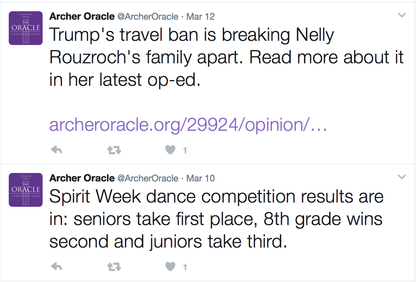 Two recent posts from my student journalists' news site Twitter. They use social media to share recently published stories and report on breaking news. Two recent posts from my student journalists' news site Twitter. They use social media to share recently published stories and report on breaking news. Social media has had such a profound effect on journalism that it's sometimes hard to remember how traditional news functioned before it. Reading this 2009 MediaShift article is a powerful reminder that Twitter wasn't always the source of breaking news. In fact, as author Julie Posetti wrote just eight years ago, "Some employers are either so afraid of the platform or so disdainful about its journalistic potential that they've tried to bar their reporters from even accessing Twitter in the workplace." Not accessing Twitter in the newsroom? It's laughable now. Yet for some high school newsrooms, this is still the case.
1 Comment
One of the biggest challenges I face as a journalism adviser is convincing my students that email interviews need to be a last resort rather than their go-to.
I get it — emails are quick and easy. Write a few questions, get responses in complete sentences back. No need to transcribe or deal with awkward verbal phrasings. Seems like a no-brainer. In a 2003 Poynter article, Jonathan Dube outlined some of the benefits of email interviews, then a relatively new journalistic tool: saving time, being efficient, creating a written record, providing time for the source to think and prepare, and working with people in different time zones or who write English better than they speak it. But he also pointed out potential pitfalls: not knowing who is replying (is this actually the superintendent, or did she just hand it off to an assistant?), not being able to follow up with more questions based on the direction of the interview, losing control of the interview transcript, missing out on body language and verbal cues that might provide more insight, and — ultimately — ending up with an interview that is unlikely to provide revealing or new information. |
About“And though she be but little, she is fierce!” -A Midsummer Night’s Dream Archives
December 2020
Categories
All
|

 RSS Feed
RSS Feed